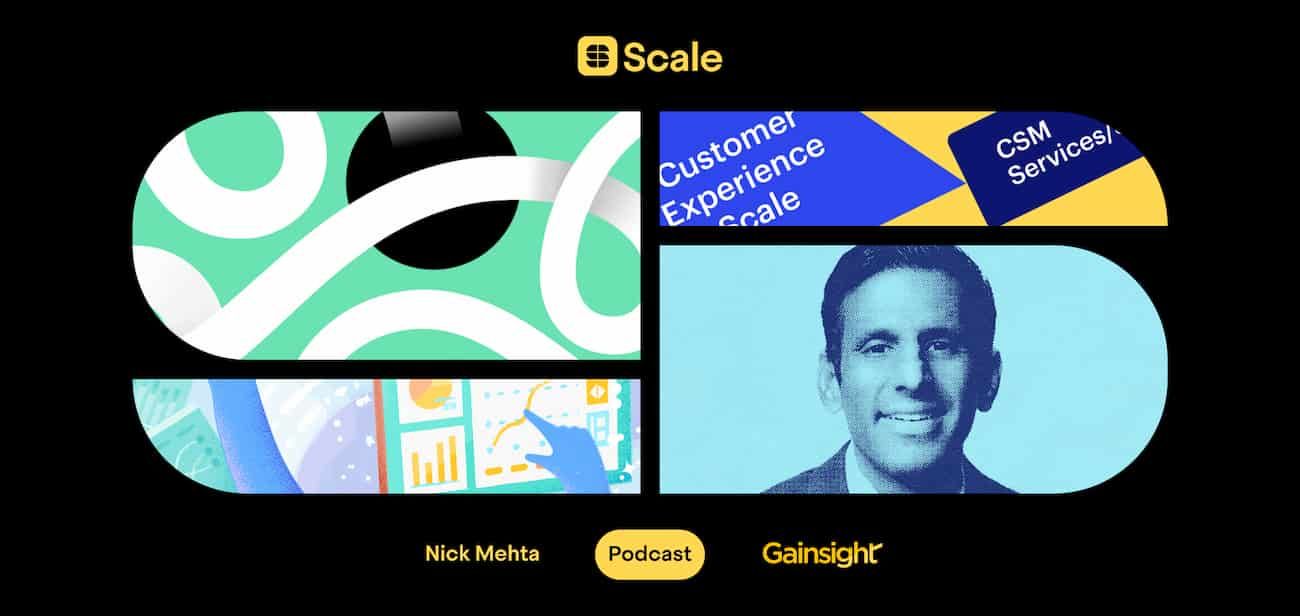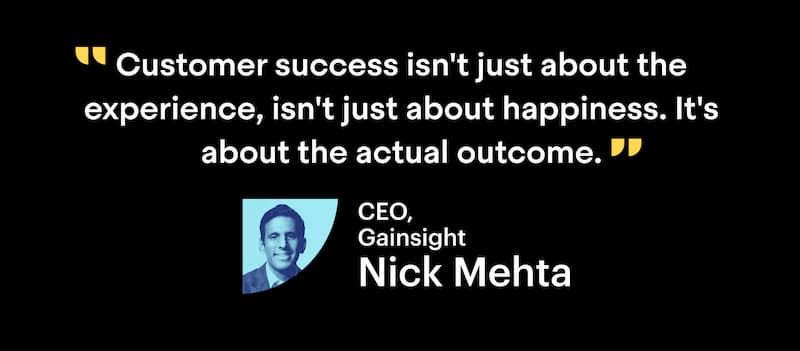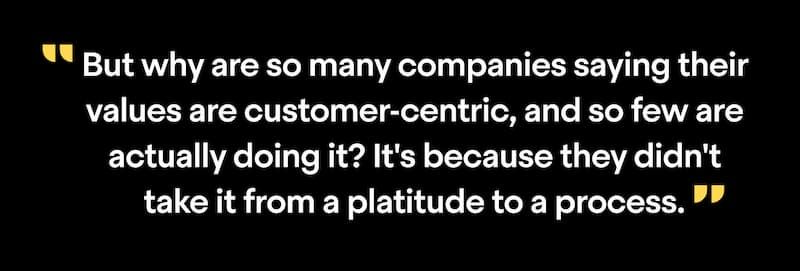
Solving the customer success equation: Nick Mehta on delivering value at scale
Customer success can often feel like an ambiguous and unquantifiable concept, yet maintaining your performance in this area is essential for scaling your business.
Few are better placed to explain the concept of customer success than Nick Mehta. As CEO of Gainsight, he has done more than most to popularize the category in the B2B SaaS world, and these efforts recently culminated in the company being acquired by Vista Equity Partners for $1.1 billion.
Nick’s belief that business is personal underpins his outlook, and he takes a “human-first” approach in his role. Not only is it the name for his own interview series, it’s the evolution of his own thinking about the attributes that leaders need today.
Those beliefs are at the core of customer success: that it’s about a relationship that goes beyond a transaction between company and customer. Nick has developed an equation to describe what he means: customer success (CS) = customer experience (CX) + customer outcomes (CO).
He’s also elaborated on this concept in a new book, written with Allison Pickens, called The Customer Success Economy: Why Every Aspect of Your Business Model Needs a Paradigm Shift. In it, he explains why customer success isn’t just a job function but a company-wide priority.
Intercom’s Kaitlin Pettersen recently caught up with Nick to break down his equation, and explore why customer success needs to move from a platitude to a process.
Listen to the full episode above or check out Nick’s key takeaways below.
The customer is in the driving seat
As Nick explains it, the “as a service” business model fundamentally changes the dynamic between company and customer. When customers have the option to cancel a service at the click of a button, suddenly they’re the ones with power in the relationship.

It’s in the vendor’s interest to make sure the customer is getting the most from the product and using the full scope of its features. Consumers expect a great experience – in the B2B world, experience matters – but for today’s modern consumer, value is now on par with experience.
“Businesses don’t buy stuff – whether it’s products or technology or whatever – just to be happy, right? In the B2B world, it’s not just about the experience. It’s also about what’s the value this vendor is driving for me. What’s the economic value? What’s the ROI? And the term people often use is outcome. What’s the outcome this vendor is driving? Are they helping my company grow faster? Are they helping me save money? Are they helping me make my employees happier?”
From reactive to proactive customer support
That’s where customer success differs from customer support. Traditional customer support is reactive; something has to stop working before the customer reaches out with an issue. On the other hand, customer success is proactive. It contextualizes user behavior to provide an in-depth understanding of how to improve the customer experience, while managing customer expectations.
If a company has lots of small customers, then managing those touchpoints can become challenging as you scale. It just isn’t possible to have humans at every step of the journey. But the beauty of automation is that it can handle essential customer interactions, so a team’s capacity is no longer a barrier to growth.

Automation can handle tasks that don’t necessarily require a human touch. Customers can be guided through the onboarding process by chatbots or prompted to self-serve the first time they log into a product. It’s the context of these experiences that’s essential to a positive customer experience. As Nick explains, timing is everything:
“So automation is clearly critical in scaling, but then the second thing is you want to do the right thing at the right time. You don’t want to just be spamming the customer. You want to look at what they’ve done and what behavior they had, and what we think the next step they should take is.”
That’s where companies can use AI to analyze the data and determine the right step to take with that customer. Nick elaborates:
“Customer success then is about getting the customer proactively through the journey towards their desired outcome with a great experience, and doing that by leveraging technology to take the right action at the right time with the right channel. And that channel could be the product, could be email, could be text, things like that.”
Understanding customer outcomes at scale
When a vendor has a customer that’s having a positive experience with the product, the next step is to understand the outcomes they want to achieve – whether that’s launching a new product or exceeding their annual KPIs.
Every business is different, and if its goals are just as diverse, that becomes difficult to manage at scale. Nick says the key to managing this is to build an outcomes and value framework that makes it possible to map customer goals to a standardized taxonomy of outcomes against your product. The process might identify several areas of value that a company drives for its customers. Managing customers in this way allows you to develop a common language that’s shared throughout the company, from sales to customer success.

This approach also feeds into building an integrated experience for the customer no matter where they happen to be in the sales cycle. Gainsight does this by having a success plan that weaves together internal functions to help customers realize their goals. Sales fill in the plan, and customer success makes the plan a reality. It starts by capturing the customer’s goals and desired outcomes, along with the history of their interactions with the company. Gainsight leverages its tech stack, which includes Gong to record interactions, together with a case management system and Intercom for communicating with customers across all channels.
This creates a consistent experience that scales, as Nick explains:
“The key is making the customer feel like they don’t have to explain themselves over and over again, and that instead of feeling like a handoff, it feels like this team is actually kind of operating as one unit. One of our customers uses the expression ‘hugs not handoffs’, which I think is cool.”
Customer success as a company-wide priority
With sales and success aligned, the next element that can drive an integrated customer journey towards outcomes should be obvious. What’s the one element that’s common to the customer of any business? The product.

Nick outlines three elements within the product that link to customer success. The first is data.
“You should have great data about your behavior for your users in the product. It’s 2020. It is completely unacceptable to have to survey users to understand what they’re doing in your product when your product is sitting in the cloud and you should be able to see that, right?”
Secondly, companies should look to embed virtual customer success within the product itself. That could be onboarding new users, telling them about new features, or noticing where they haven’t taken the right next step. Echoing his earlier point about automation, Nick says:
“You should be able to do that through nudges in the product, not just through a CSM reaching out or a salesperson.”
The third element is to have close collaboration between the CS team and the product team on the future direction of the product, because the product team now has data on user behavior, together with a sense of what the user experience should be, while the CS team has first-person stories about the outcomes for those customers.

Nick jokingly calls the three elements of sales, CSM, and product the “Three Musketeers.”
“Now what it has to evolve from though is it can’t just be a company-wide platitude. A lot of companies – in fact, I’d argue every single company now that’s worth their salt – has some value that says they’re customer-centric, right? But why are so many companies saying their values are customer centric, and so few are actually doing it? It’s because they didn’t take it from a platitude to a process. What is the company-wide business process to get our clients from the value that we promised them to the value that we’ve delivered? That’s why customer success has become a company-wide priority.”
Getting them aligned with the right processes in place is at the crux of his thinking. Yet too many companies still treat customer success as a silo, with no connection to product or sales.

Alignment across these three pillars ensures that customers get value from your service. And that process of driving value for a customer is customer success. But to work at scale, it has to become a company-wide priority.









